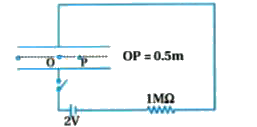The terminology different parts of the electromagnetic spectrum is given in the text. Use the formula E = hv (for energy of a quantum of radiation : photon) and obtain the photon energy in units of eV different parts of the electromagnetic spectrum. In what way are the different scales of photon energies that you obtain related to the sources of electromagnetic radiation ? Solution in Gujrati
Entire electromagnetic spectrum can be divided into following six sections. Corresponding to average frequency v in each section, energy of one photon is E = hv
(Where h=6.625×10−34Js)
(i) For section of radio waves, v=3×108Hz
E=hv=6.625×10−34×3×108
=19.88×10−26J
∴E=19.88×10−261.6×10−19eV=12.42×10−7eV
=1.242×10−6eV
Oscillating charge is the source of above radiation.
(ii) For infrared waves, v=1013 Hz. Hence,
E=hv=(6.625×10−34)(10−13)
=6.625×10−21J
∴E=6.625×10−211.6×10−19eV
∴E=4.141×10−2eV
Atomic and molecular excitation are the sources of above radiation.
(iii) For visible light v=6×1014 Hz. Hence
E=hv=(6.625×10−34)(6×1014)
=3.975×10−19J
∴E=3.975×10−191.6×10−19=2.484eV
Transition of valence electron in an atom is the source of above radiation.
(iv) For ultraviolet light, v=1015 Hz. Hence
E=hv=(6.625×10−34)(1015)
=6.625×10−19J
∴E=6.625×10−191.6×10−19=4.141eV
Excited atom emits above radiation.
(v) For X - rays, v=3×1018 Hz. Hence
E=hv=(6.625×10−34)(3×1018)
=1.988×10−15J
∴E=1.988×10−151.6×10−19=1.242×104eV
When highly energetic electron collides and loses all of its energy suddenly, above radiation is emitted.
(vi) For γ rays, v=3×1020 Hz. Hence
E=hv=(6.625×10−34)(3×1020)
=1.988×10−13J
∴E=1.988×10−131.6×10−19=1.242×106eV
Excited radioactive nucleus is the source of above radiation.
Topper's Solved these Questions
- BOOK - KUMAR PRAKASHANCHAPTER - ELECTROMAGNETIC WAVESEXERCISE - SECTION B NUMERICALS (Numerical From .DARPAN. Based On Textbook)12videos
ELECTROMAGNETIC WAVES
- BOOK - KUMAR PRAKASHANCHAPTER - ELECTROMAGNETIC WAVESEXERCISE - SECTION C NCERT EXEMPLAR SOLUTION (Multiple Choice Questions)13videos
ELECTROMAGNETIC WAVES
- BOOK - KUMAR PRAKASHANCHAPTER - ELECTROMAGNETIC WAVESEXERCISE - SECTION B NUMERICALS (Numerical From Textual Illustrations)18videos
ELECTROMAGNETIC WAVES
- BOOK - KUMAR PRAKASHANCHAPTER - ELECTROMAGNETIC INDUCTIONEXERCISE - Section D MCQs (MCQs asked in Competitive Exams )38videos
ELECTROMAGNETIC INDUCTION
- BOOK - KUMAR PRAKASHANCHAPTER - ELECTROSTATIC POTENTIAL AND CAPACITANCEEXERCISE - Section D ( MCQs asked in Cometitive Exams )39videos
ELECTROSTATIC POTENTIAL AND CAPACITANCE
Similar Questions
The maximum electric field at a distance of 10m from an isotropic point source of light is 3.0Vm−1. Calculate (a) the maximum value of magnetic field, (b) average intensity of light at that place and (c ) the power of the source. [c=3×108ms−1,ε0=8.854×10−12C2N−1m−2]
03:08View SolutionOne requires 11eV of energy to dissociate a carbon monoxide molecule into carbon and oxygen atoms. The minimum frequency of the appropriate electromagnetic radiation to achieve the dissociation lies in
03:46View SolutionA parallel plate capacitor with circular plates of radius 1 m has a capacitance of 1 nF. At t = 0, it is connected for charging in series with a resistor R=1MO¬a across a 2V battery. Calculate the magnetic field at a point P, halfway between the centre and the periphery of the plates, after t=10−3s. (The charge on the capacitor at time t is q (t) = CV [1 - exp (−t/τ)], where the time constant τ is equal to CR.)
 13:46View Solution
13:46View SolutionThree pure inductance each of 3 H are connected as shown in figure. The equivalent inductance of this connection between points A and B is ......
 02:26View Solution
02:26View SolutionCapacitance of a capacitor 100 μ F. The work is done for depositing chargc 8×10−18 C on it will be .........
07:47View SolutionPhotons of an electromagnetic radiation has an energy 11 keV each. To which region of electromagnetic spectrum does it belong ?
02:43View SolutionThe terminology of different parts of the electromagnetic spectrum is given in the text. Use the formula E = h ν (for energy of a quantum of radiation: photon) and obtain the photon energy in units of eV for different parts of the electromagnetic spectrum. In what way are the different scales of photon energies that you obtain related to the sources of electromagnetic radiation?
View Solutionवैद्युत चुंबकीय स्पेक्ट्रम के विभिन्न भागों की पारिभाषिकी पाठयपुस्तक में दी गई है। सूत्र E=hv ( विकिरण के एक क्वांटम की ऊर्जा के लिए : फोटॉन ) का उपयोग कीजिए तथा em वर्णक्रम के विभिन्न भागों के लिए eV के मात्रक में फोटॉन की ऊर्जा निकालिए। फोटॅान ऊर्जा के जो विभिन्न परिणाम आप पाते हैं वे वैद्युत चुंबकीय विकिरण के स्त्रोतो से किस प्रकार संबधित हैं ?
01:30View Solution6.0eV ऊर्जा वाला फोटोन विघुत -चुम्बकीय स्पेक्ट्रम के किस भाग में पढता है ?
04:56View Solutionसूत्र E = hv (विकिरण के एक क्वांटम की ऊर्जा के लिए : फोटॉन) का उपयोग कीजिए तथा विधुतचुम्बकिय वर्णक्रम के विभिन्न भागो के लिए eV के मात्रक में फोटॉन की ऊर्जा निकालिए । फोटॉन ऊर्जा के जो विभिन्न परिणाम हैं वे वैधुतचुम्बकिय विकिरण के स्रोतों से किस प्रकार सम्बंधित हैं ?
04:56View Solutionयदि विधुत चुम्बकीय विकिरण का तरंगदैघ्र्य दुगुना कर दिया जाये टी फोटों की ऊर्जा कैनी होगी ?
03:03View SolutionThe terminology of different parts of the electromagnetic spectrum is given in the text. Use the formula E = hv (for energy of a quantum of radiation: photon) and obtain the photon energy in units of eV for different parts of the electromagnetic spectrum. In what way are the different scales of photon energies that you obtain related to the sources of electromagnetic radiation ?
View SolutionThe wavelength of electromagnetic radiation is doubled. What will happen to the energy of the photons of the new radiation ?
02:09View SolutionThe terminology of different parts of the electromagnetic spectrum is given in the text. Use the formula E=hυ (for energy of a quantum of radiation : photon) and obtain the photon energy in units of eV for different parts of the electromagnetic spectrum. In what way are the different scales of photon energies that you obtain related to the sources of electromagnetic radiation ?
View SolutionThe terminology of different parts of the electromagnetic spectrum is given in the text. Use the formula E=hυ (for energy of a quantum of radiation : photon) and obtain the photon energy in units of eV for different parts of the electromagnetic spectrum. In what way are the different scales of photon energies that you obtain related to the sources of electromagnetic radiation ?
02:55View Solution

